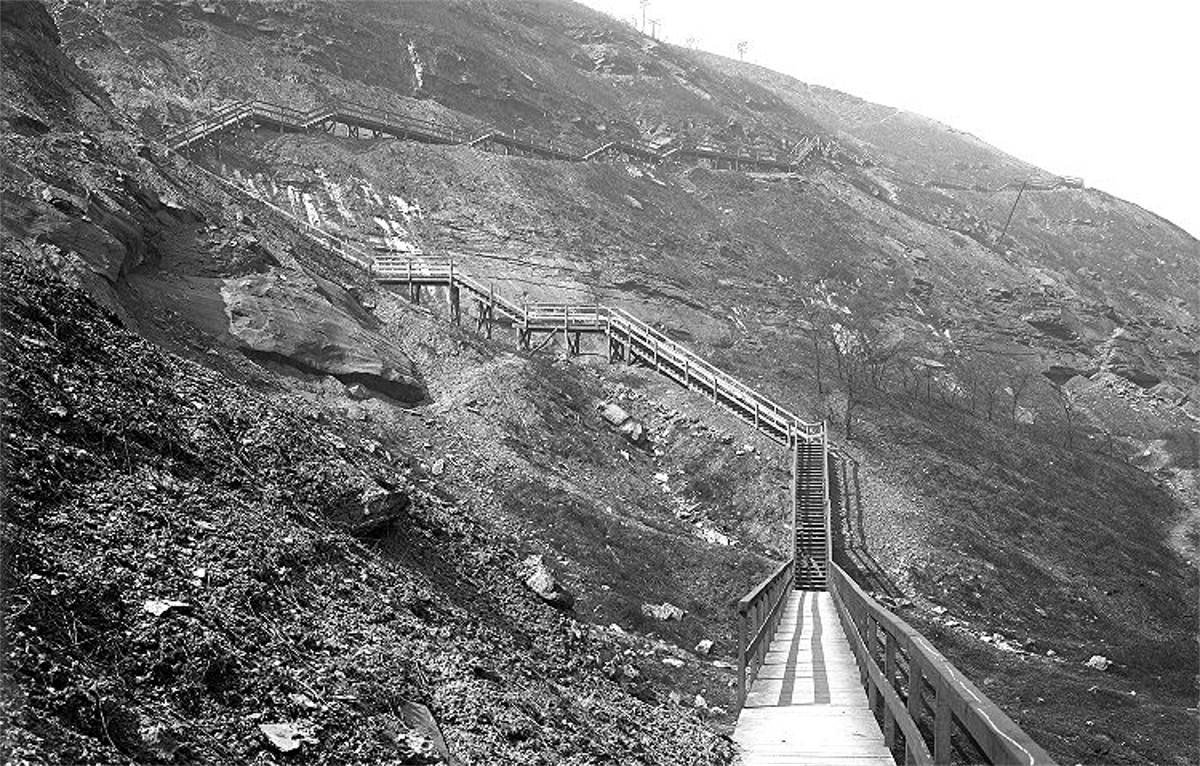In Literature Appetizer, Ben gives you just a taste of a book. Not meant to replace the full meal, this is meant to whet your appetite. Bon appetit!
Indian Steps trail. Retrieved from Brookline Connection
Pittsburgh Then and Now by the History & Landmarks Foundation Pittsburgh
I have seen pictures of Pittsburgh back in the day and know the famous “Hell with the Lid Off” quote about the city. But something that doesn’t get mentioned as often is how treeless the city used to be.
While going over these pictures, I found myself asking “but where are any plants? It is just soil and concrete.” Pittsburgh now isn’t as forested as I would like it to be, but it seems like a dense forest compared to what it used to be. Reading this alongside Pittsburgh Steps gave me a new appreciation of the city I call home.
Pittsburgh Steps by Bob Regan
There is a shift in the term “nerd” from someone who only likes “nerdy things” to someone who is extremely passionate about a specific subject. In that respect, this was the nerdiest yet wonderful book I read this season.
While now almost a decade old, Regan discusses in hyper detail about the state of steps in Pittsburgh and how they came to be. Even though I have lived officially in the city for years, I always thought the steps were private property or just something the neighborhood built. Over 300 of our steps are actual City Streets! The ‘burgh has to maintain them just as they maintain all of our sidewalks and roads.
If you would like to see where the steps are, feel free to check out this interactive map of the steps!
What you are getting wrong about Appalachia by Elizabeth Catte
While this was written in 2018, I feel like it is even more relevant now. Catte discusses the media’s obsession with only a narrow view of Appalachia; poor, white, conservative. Especially since JD Vance’s Hillbilly Elegy was also making rounds at the same time. Both that book and the media’s narrow focus ignores the diversity and struggles that Appalachians face. To paraphrase Catte “I know all Appalachians are sick and tired of powerful people coming to our hills and hollers to take our streams, health, and stories.”
It also showed me how much I have grown in my own journey of being an Appalachian. When I first read American Nations, I loved how it discussed the region of Greater Appalachia. But as I have grown and listened to a lot more voices from the region, that book takes the same narrow view as Hillbilly Elegy.
If you only read one book on this list, I cannot recommend this one enough.
Woolly by Ben Mezrich
This book does a great job describing how scientists collaborate together across departments and even outside of academia to complete a project. Personally, I felt like this focused too much on the people going through the process, and not enough about mammoths, but I think other readers will enjoy the personal aspect of this.
What if we get it right? by Dr. Ayana Elizabeth Johnson
I first heard of Dr. Ayana Elizabeth Johnson on the podcast How to Save a Planet. She instantly became my favorite scientist discussing the Climate Crisis. Her specialty is Marine Biology, but she also works in Policy (especially Ocean Policy). She brought a realness and joy to the podcast that I felt was missing from the other Climate Podcasts I listen to.
When she left, I was heartbroken. But I knew she was going to do great things. A few years later, she announced the release of this book.
If I were to design a class on teaching the Climate Crisis, this would be on top of the required reading list. While The Ends of the World did a great job going over what could happen if we do nothing, and the relationship our current situation has with the history of this planet, What if we get it right? tells us not only what we need to fix (and boy there is a lot), but also how to actually get things done.
I’ll leave you with her sixth footnote. This is early on in the book when discussing individual carbon footprints.
“The useful term “carbon footprint,” by the way, was popularized by fossil fuel companies, in an attempt to put the weight of the blame on us as individuals. Get outta here with that nonsense.”
Walden & Civil Disobedience by Henry David Thoreau
Thoreau is seen as a classic and foundational nature writer in America. He is so foundational, that all of my schools (High School, College, Grad School) assumed I had already read Walden and didn’t teach it. I was excited to fill in the gap that my education made.
But oh boy, Thoreau is a jerk. He would write incredibly detailed experiences about his time at the pond, but then make a sudden turn to belittle poor folk for wanting more. This felt like there were actually three books in one; nature writing, autobiography, and social justice. The problem that I had was he would switch between them so drastically and without transition that I felt like I picked up a different book.
Overall, glad I can say I have read it to fill in the gap, but I will not be going back to this book in the future.
Half Earth by E.O. Wilson
Wilson argues for a radical change due to the radical Crisis we are in: half of the Earth should be left for non-human development. Currently 15% of the globe qualifies, but that is far from where we need to be.
I didn’t realize until I started this book, but it is actually the third installment on his series on humanity as a whole. This book felt like three smaller books combined into one. If you just want to get to his argument, skip to the 3rd section. While I enjoyed the first two (giving context to the situation and describing his love as a naturalist), the argument that he lays out is pretty clear.
Without drastic, radical change we will lose the biodiversity of our global ecosystem, making it extremely fragile for the Climate Crisis we are in.
As Long as Grass Grows by Dina Gilio-Whitaker
Even though it wasn’t intended to be, I see this as an important co-read with An Indigenous Peoples’ History of the United States. Both do an excellent job giving context historically for where we are today. As Long as Grass Grows focuses on the intersection with Indigenous sovereignty and the environmental movement. Highly, highly recommend.
The Lives of a Cell by Lewis Thomas
I picked up this book back in 2016 when the Library at NCI was trying to fit new books into their collection. I finished it this season, but it was ok. I was expecting it to be more about writing about a specific landscape or ecosystem. Thomas instead writes about his perspective on society in 1970’s England through the lens of a biologist. I’ll be donating this to a little library near me.
The Beekeeper’s Lament by Hannah Nordhaus
This is a little window into the life of a bee keeper. While it does touch on the business as a whole, as well as putting it all into historical context, a lot of time is spent on one bee keeper in particular. A great read if you are interested in learning about the pollinating backbone of America.
A History of the World in 6 Glasses by Tom Standage
What a wonderful little read! Standage did a great job walking me through history to make sure it wasn’t whitewashed, while making it approachable. The part I loved the most is early on in the book when he was discussing the fierce debate happening in the academic world. Which came first: beer or bread? It honestly made me feel more connected to the countless generations before me.
The Expanse Series by James S. A. Corey
I actually finished this series awhile ago, but thought it would be great to compare to Seveneves and the Mars Trilogy, since I just finished the later this season.
My first experience with the Expanse was the FX show. I fell in love not only with the world but with the characters. It just felt like D&D adventure but with spaceships. After the show finished I went back to read all nine books and have even bought all the books for the Role Playing Game.
Just as a taste of how it approaches Sci-Fi different than what I have experienced before, let’s chat space travel. Think of a standard rocket ship in any Sci-Fi setting. From Star Trek to Star Wars, most ships are like big airplanes. The captain needs to have little windows to see out, and when they are sitting their back is away from where they are going (where the rockets/propulsion system is).
But in the Expanse, ships are like buildings. It doesn’t need to be aerodynamic if it only stays in space, so most take on rectangular shapes. Their seats are also positioned so your feet/butt is closer the propulsion system. This may seem weird at first, but think about how “gravity” is on our planes versus space ships. Our planes on earth not only have thrust to push us forward, but also have the gravity of the planet to orient ourselves. If you placed your back like they do in Star Trek, the propulsion of the ship would feel like you have your back to the floor. Your feet would be on the wall.
And that’s why every time I watch other Sci-Fi series I get a little annoying voice that says “Umm, Actually the ship wouldn’t fly like that.”
Seveneves by Neal Stephenson
Instead of a distant future like the Expanse, Seveneves opens with the moon exploding into seven pieces around present day Earth. Why? Doesn’t matter. How? Doesn’t matter. What does matter is how humanity will react to it.
It was a fantastic but stressful journey through our way of live suddenly changing. It did give me a stress headache multiple times, so be prepared for a rough read. If you make it to the other side let me know so we can discuss how horribly wonderful this book is.
Mars Trilogy by Kim Stanley Robinson
Never before have I read a series that makes me love the world so much, while hating the majority of the characters. Robinson does such a great job going into detail how a society would form on Mars of hundreds of years. The ideas that the character discuss, or the problems they have are fascinating. But so often I found myself trying to skip the dialogue of certain characters.
The best example I can give without spoilers is two of the first batch on Mars are Russian women. One is a builder while the other is a leader. They are walking on the surface trying to solve a problem with the life support systems. The leader keeps talking on and on about how she doesn’t know if she loves American Man 1 or American Man 2. This goes on for pages. The builder thinks “oh could you just shut up so we can focus on this.” I repeated that phrase out lead when I read it because I agreed with the builder so much.
If you can get past some of the characters, the journey of colonizing Mars is a fascinating tale.


